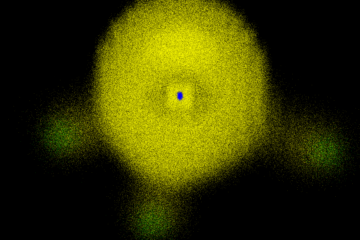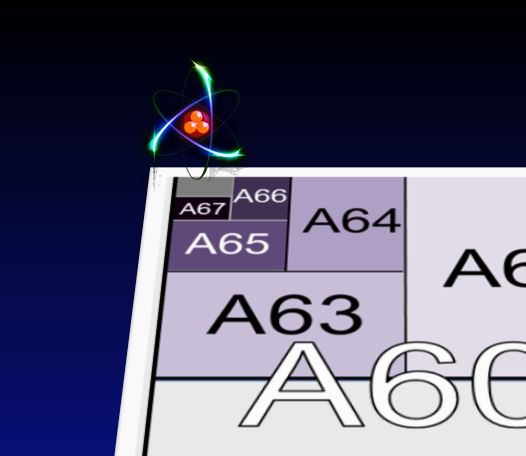When you stand up, your head gets older faster than your feet by one femtosecond every ten seconds. This and eight other facts about the femtosecond you never thought of.
In my work, I have to deal with things happening in the femtosecond timescale on a daily basis. That’s because simulations of ultrafast molecular processes grant my salary. An example is in the movie above. One femtosecond (1 fs) names an astonishingly short time of 10-15 second. This timescale is adequate to describe some basic atomic and molecular processes in a field of research fancifully called femtochemistry.
My professional mind lives in a world where I must know by heart that a hydrogen transfer induced by radiation (just like in the movie) occurs within 10 fs; that the response of retinal molecules to the light reaching our retina happens within 200 fs; that the nucleobases in our DNA relax after sun excitation within 1000 fs.
Working on these scales, I’ve been losing track of what really means one femtosecond and of its relative importance when compared to other chemical processes happening in other time scales. Then, as an exercise to myself, I tried to put the femtosecond in perspective, by looking for examples of how it relates to things out of my métier. I will share these thoughts with you.
- One femtosecond is such a short period that if it were equivalent to 1 s, then 1 s would be equivalent to 60 million years.
- On the other hand, compared to the Planck time (tP)—the shortest unit of time possible—1 fs is a very long time lag. If 1 tP were 1 fs, then 1 fs would be equivalent to 600 thousand years.
- In 1 fs, an electron makes about 1/6 of a turn around a hydrogen atom in the Bohr model.
- Electromagnetic waves oscillating with 1 fs period have a wavelength of 300 nm, just in the middle of the UVB region of the spectrum. If you are irradiated with them, you may have some serious skin burns or even skin cancer.
- Due to the time-energy uncertainty principle laser pulses of 1 fs duration have rather low energy resolution. If the matter is irradiated with such ultrashort pulses, say centered at 580 nm (yellow), then energy gaps from 539 nm (green) to 628 nm (red) can be excited.
- In 1 fs, light travels 500 nm, only 1/20 of a single hair width.
- If you walk fast, say at 6 km/h, special theory of relativity grants that after 1 minute you will be younger than people resting by 1 fs.
- When you stand up, your feet are closer to the center of Earth than your head. Due to the slightly different gravitational pools, the general theory of relativity predicts that your head is getting older than your feet at a rate of 1 fs for every 10 s.
- And how fast are our thoughts compared to the femtosecond world? I remember the lyrics of an old, beautiful Brazilian song saying that:
“If I bring my hands distant from my chest is due to the distance between intention and gesture.”
Well, nervous electric signals run in our body at a speed of 100 m/s. It takes 0.01 s (or 1013 fs) to go all the way from the brain to the hands. The poet was right: from the femtosecond perspective, the distance between intention and gesture is just eternity. MB
A bit of the mathematics to get the relations in this post:
The Planck time is defined by tP = (ħGc-5)1/2 = 5.39 x 10-44 s, where ħ is the reduced Planck constant, G is the gravitational constant, and c is the speed of light.
The electron orbital period in the Bohr model can be computed as τ = 2πa0(αc)-1, where a0 is the Bohr radius and α is the fine-structure constant. The wave period (T) is related to radiation wavelength (λ) by T = λ/c.
The time-energy uncertainty principle is given by ΔtΔE ≥ ħ/2. Time dilation in special relativity says that a delay of δt is accumulated every Δt. These quantities are related by δt = (γ-1) Δt, where γ = (1-v2/c2)-1/2 and v is the observer speed.
Gravitational time dilation: near a massive body with mass M, a delay of δt is accumulated every Δt for an observer at a distance R from the center of the body in comparison to another observer at R+h from the center.
In general relativity with a Schwarzchild metric, the time delay caused by a spherically symmetric massive body is computed as δt = [(1-r0/R)1/2-(1-r0/(R+h))1/2] Δt, where r0 = 2GM/c2.
- This post is a revised version of a text first published in my former blog Much Bigger Outside on October 26, 2014.
- While you’re here, check my first fiction book, “One Billion Faces.“




1 Comment
As Small As an Atom – Light and Molecules · December 24, 2019 at 7:23 AM
[…] a previous post, I did a quick exercise relating the femtosecond, the time scale in which atomic phenomena take place, to diverse other aspects of life, universe, […]
Comments are closed.